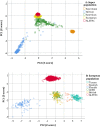Interplay between genome-wide implicated genetic variants and environmental factors related to childhood antisocial behavior in the UK ALSPAC cohort
- PMID: 30569215
- PMCID: PMC6689282
- DOI: 10.1007/s00406-018-0964-5
Interplay between genome-wide implicated genetic variants and environmental factors related to childhood antisocial behavior in the UK ALSPAC cohort
Abstract
We investigated gene-environment (G × E) interactions related to childhood antisocial behavior between polymorphisms implicated by recent genome-wide association studies (GWASs) and two key environmental adversities (maltreatment and smoking during pregnancy) in a large population cohort (ALSPAC). We also studied the MAOA candidate gene and addressed comorbid attention-deficit/hyperactivity disorder (ADHD). ALSPAC is a large, prospective, ethnically homogeneous British cohort. Our outcome consisted of mother-rated conduct disorder symptom scores at age 7;9 years. G × E interactions were tested in a sex-stratified way (α = 0.0031) for four GWAS-implicated variants (for males, rs4714329 and rs9471290; for females, rs2764450 and rs11215217), and a length polymorphism near the MAOA-promoter region. We found that males with rs4714329-GG (P = 0.0015) and rs9471290-AA (P = 0.0001) genotypes were significantly more susceptible to effects of smoking during pregnancy in relation to childhood antisocial behavior. Females with the rs11215217-TC genotype (P = 0.0018) were significantly less susceptible to effects of maltreatment, whereas females with the MAOA-HL genotype (P = 0.0002) were more susceptible to maltreatment effects related to antisocial behavior. After adjustment for comorbid ADHD symptomatology, aforementioned G × E's remained significant, except for rs11215217 × maltreatment, which retained only nominal significance. Genetic variants implicated by recent GWASs of antisocial behavior moderated associations of smoking during pregnancy and maltreatment with childhood antisocial behavior in the general population. While we also found a G × E interaction between the candidate gene MAOA and maltreatment, we were mostly unable to replicate the previous results regarding MAOA-G × E's. Future studies should, in addition to genome-wide implicated variants, consider polygenic and/or multimarker analyses and take into account potential sex stratification.
Keywords: ALSPAC; Aggression; Antisocial behavior; Gene–environment interaction; Maltreatment; Smoking during pregnancy.
Conflict of interest statement
I. Hyun Ruisch, Pieter J. Hoekstra, and Andrea Dietrich reported no financial interests or potential conflicts of interest. Jan K. Buitelaar was a consultant to/member of advisory board of/and/or speaker for Janssen-Cilag BV, Eli Lilly, Shire, Novartis, Roche, and Servier. Jeffrey C. Glennon has, in the past 3 years, been a consultant to Boehringer Ingelheim GmbH. Neither Jan K. Buitelaar nor Jeffrey C. Glennon is employees of any of these companies, and neither are stock shareholders of any of these companies.
Figures


Similar articles
-
MAOA, childhood maltreatment, and antisocial behavior: meta-analysis of a gene-environment interaction.Biol Psychiatry. 2014 Jan 1;75(1):9-17. doi: 10.1016/j.biopsych.2013.05.004. Epub 2013 Jun 18. Biol Psychiatry. 2014. PMID: 23786983 Free PMC article.
-
MAOA genotype, childhood maltreatment, and their interaction in the etiology of adult antisocial behaviors.Biol Psychiatry. 2014 Jan 1;75(1):25-30. doi: 10.1016/j.biopsych.2013.03.028. Epub 2013 May 28. Biol Psychiatry. 2014. PMID: 23726513 Free PMC article.
-
Interacting effect of MAOA genotype and maternal prenatal smoking on aggressive behavior in young adulthood.J Neural Transm (Vienna). 2016 Aug;123(8):885-94. doi: 10.1007/s00702-016-1582-x. Epub 2016 Jun 14. J Neural Transm (Vienna). 2016. PMID: 27300740
-
The role of monoamine oxidase A in the neurobiology of aggressive, antisocial, and violent behavior: A tale of mice and men.Prog Neurobiol. 2020 Nov;194:101875. doi: 10.1016/j.pneurobio.2020.101875. Epub 2020 Jun 20. Prog Neurobiol. 2020. PMID: 32574581 Free PMC article. Review.
-
Gene-environment interaction of monoamine oxidase A in relation to antisocial behaviour: current and future directions.J Neural Transm (Vienna). 2018 Nov;125(11):1601-1626. doi: 10.1007/s00702-018-1892-2. Epub 2018 Jun 7. J Neural Transm (Vienna). 2018. PMID: 29881923 Free PMC article. Review.
Cited by
-
Effects of Childhood Adversity and Its Interaction with the MAOA, BDNF, and COMT Polymorphisms on Subclinical Attention Deficit/Hyperactivity Symptoms in Generally Healthy Youth.Children (Basel). 2020 Sep 3;7(9):122. doi: 10.3390/children7090122. Children (Basel). 2020. PMID: 32899127 Free PMC article.
-
Connecting phenotype to genotype: PheWAS-inspired analysis of autism spectrum disorder.Front Hum Neurosci. 2022 Oct 12;16:960991. doi: 10.3389/fnhum.2022.960991. eCollection 2022. Front Hum Neurosci. 2022. PMID: 36310845 Free PMC article.
-
From warrior genes to translational solutions: novel insights into monoamine oxidases (MAOs) and aggression.Transl Psychiatry. 2021 Feb 18;11(1):130. doi: 10.1038/s41398-021-01257-2. Transl Psychiatry. 2021. PMID: 33602896 Free PMC article. Review.
-
Exploring the Genomic Architectures of Health, Physical Traits and Antisocial Behavioral Outcomes: A Brief Report.Front Psychiatry. 2020 Jun 25;11:539. doi: 10.3389/fpsyt.2020.00539. eCollection 2020. Front Psychiatry. 2020. PMID: 32670102 Free PMC article.
-
Aggression based genome-wide, glutamatergic, dopaminergic and neuroendocrine polygenic risk scores predict callous-unemotional traits.Neuropsychopharmacology. 2020 Apr;45(5):761-769. doi: 10.1038/s41386-020-0608-0. Epub 2020 Jan 9. Neuropsychopharmacology. 2020. PMID: 31918432 Free PMC article.
References
-
- American Psychiatric Association . Diagnostic and statistical manual of mental disorders. 5. Washington, DC: American Psychiatric Association; 2013.
-
- Robins L. Epidemiology of antisocial personality disorder. In: Michels R, Cavenar JO, editors. Psychiatry. Philadelphia: Lippincott; 1987. pp. 1–14.
MeSH terms
Substances
Grants and funding
LinkOut - more resources
Full Text Sources
Medical

